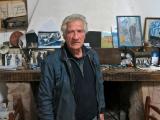Pinuccio Sciola (San sperate, March 15, 1942) is an Italian sculptor.
Internationally renowned artist , is known for his work in the promotion of murals in San sperate and for his sculptures, especially for the "sound stones."
In 1959 he took part as a self-taught at an exhibition contest for students of all ages and order of study, winning a scholarship that allowed him to attend the Art School of Cagliari.
In 1967 he won a scholarship to attend the University of Moncloa in Madrid , during which time he studied the cave paintings of Altamira Caves. In May '68 in Paris. In the same year , returned to his country , decided to turn St. Hope in a "town-museum" . So in the walls of the village houses, completely repainted white lime , are painted with murals and squares are laid various sculptures . This initiative involves a large part of the population and has a large following , not only among his countrymen , but also among many artists, eg. Fois Fois, Gaetano Brundu, Prime Pantoliano, George Princivalle. In the same year he obtained the chair of sculpture at the Art School of Cagliari.
The activity in the country-museum of San sperate attracts the attention of UNESCO in 1973 Pinuccio Scioli calls to go to Mexico. There she meets the master muralist David Alfaro Siqueiros, learns the secrets and collaborates with large murals in the populous district Tepito.
In 1976 he took part in the Venice Biennale arousing no small stir among critics for the show in St. Mark's Square and Le Canne de Corpse, wood carvings. Active in his native country in 1978, the International School of Sculpture. It is present with his works at the Quadrennial of Rome, Barcelona, Paris, Vienna and so on. and between '86 and '87 in the museums of modern art in various cities in Germany.
Near Stuttgart, in the old town of Kirchheim Unter Teck, one of his sculptures was laid as the foundation stone of the European Parliament .
His works, especially sculptures are part of public and private collections and are exhibited in various museums and placed in squares, parks and places especially in Europe: in 1986 in the public gardens of Arnhem in the Netherlands, in 1994 in Castle Park Ooidonk in Belgium in 1996 Trianon Palace Versailles in 1997 in the Park Center Kunst Project Bärndorf Bei Baden near Vienna.

